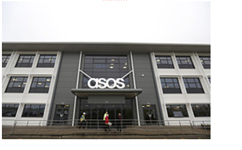Bell Says: |
 |
| One of the problems of operating global distribution centers is the concentration of risk in one location. |
|
What Do You Say?
|
|
|
|
Previous Columns by
Cliff Holste |
|
|
Date Line: June 23, 2014 3:50 a.m. ET
LONDON—British online fashion retailer Asos PLC started taking orders again early Monday after a fire at its main warehouse in northern England destroyed about of fifth of the stock at the site.
The fire broke out late Friday at the distribution center in Barnsley where Asos said it held around 70% of its £159 million ($270 million) in inventory. Based on those figures for the end of May, the fire destroyed around £22 million in Asos products.

A fire late last Friday destroyed millions of dollars' worth of stock at Asos Plc's main warehouse, pictured here last April, in Barnsley, northern England. Bloomberg News
Local police said they have opened a criminal investigation into the fire and are treating it as deliberate. No arrests had been made as of Sunday, police said.
Asos said on Monday that it is fully insured for loss of stock and business interruption.
The fire is the latest setback for the publicly traded company which styles itself as the U.K.'s largest online fashion retailer selling more than 850 brands including its own-label men's and women's clothing.
Earlier this month, the Asos issued its second profit warning of the year, citing the strength of sterling against other major currencies which had crimped revenue and profit. Asos sets prices in sterling and converts to local prices overseas, instead of initially pricing its products in the local currency. More than 60% of the company's sales are overseas. In the quarter that ended May 31, the company notched up revenue of £243 million.
Asos said it had taken down its website after the fire late Friday night ripped through four floors of the company's warehouse.
A company spokesman said there was little if any structural damage to the building, though police described the damage as substantial. With more than a half million square feet of space, the building serves as Asos' primary warehouse, although the company has a secondary one for returns and one in the U.S., a spokesman said.
About 500 workers were on site at the time of the fire, though nobody was injured, police and company officials said.
USA Warehouse Fire Statics:
During 2007-2011, an estimated average of 1,270 structure fires in warehouses were reported to U.S. fire departments each year, with associated annual losses of 4 civilian deaths, 23 civilian injuries, and $188 million in direct property damage. Nearly one-fifth of these fires were set intentionally. Electrical distribution or lighting equipment was involved in 13% of fires. Electrical failure or malfunction was the leading factor contributing to the ignition of warehouse fires, as well as in contributing to direct property damage and to civilian injuries, representing 19% of the total in each category.
These estimates are based on latest data available from the U.S. Fire Administration’s (USFA’s) National Fire Incident Reporting System (NFIRS) and the National Fire Protection Association’s (NFPA’s) annual fire department experience survey.
Understanding Associated Consolidation Risks:
Contributed by: www.koganpage.com
John Manners-Bell, author of the recently published ‘Supply Chain Risk’ book, commented, ‘One of the problems of operating global distribution centers is the concentration of risk in one location. Centralization of logistics operations makes sense on an operational basis in terms of keeping stock levels low and reducing redundancy. However if you start costing in external risks such as fires, floods and security issues, then suddenly it doesn’t look so smart. As it is very difficult to quantify the financial cost of ‘Black Swan’ events, many companies pretend that the risks don’t exist. Although ASOS had insurance and the disaster could have been a lot worse, there will still be implications for the retailer in terms of customer service and reputation.
He went on to add, ‘To get back up and running so quickly, ASOS obviously had exceptional contingency plans in place, no doubt helped by an earlier experience when its previous distribution center in the UK was badly damaged by an oil depot blast. However this further disaster demonstrates the systemic fragility of many global supply chains and perhaps suggests that it would be sensible to spread risk over a number of locations, despite an increase in internal supply chain costs.
About 'Supply Chain Risk: Understanding Emerging Threats to Global Supply Chains'
The book (on www.Amazon.com) assesses the various sources of external threat to the supply chain, including environmental, geopolitical, economic and technological. The author clearly describes the evolving risks to supply chains and how multinational corporations should be dealing with them at a strategic level.
About John Manners-Bell
John’s career has spanned research, strategy and marketing within the logistics and supply chain industry. He combines a deep seated interest in the subject with a passion for writing and speaking. In 2002 John founded the research company Transport Intelligence Ltd which has attained a market leading position in the provision of market research with offices in the UK, USA and Hong Kong.
|